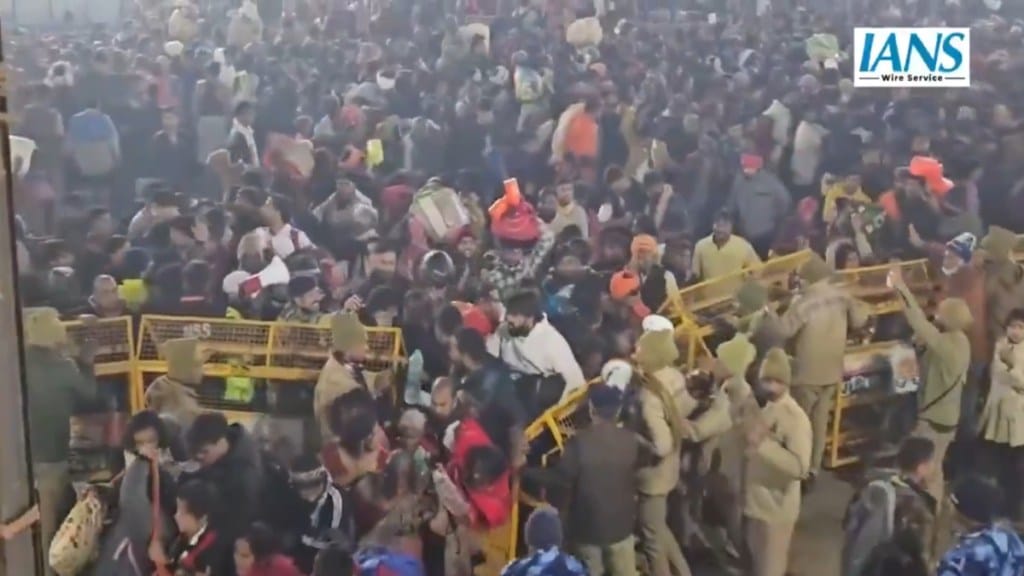Six people lost their lives, and dozens were injured in a stampede at the Mansa Devi Temple in Haridwar, where a large number of devotees had gathered. According to Nilesh Bharne, IG Law and Order, the stampede was triggered by panic after a rumour spread about a snapped electric wire. “There was some rumour about electricity hazards, creating panic among the devotees, leading to the situation…,” Bharne was quoted by The Indian Express as saying.
While initial reports blamed the incident on the rumour, officials later shrugged it off, saying that it didn’t happen. They said that the tragic incident took place after a devotee slipped on the temple steps.
The President of the Mansa Devi Temple trust also maintained this version. He told the news agency ANI that the grave tragedy did not happen because of “electrocution”. “This is not an incident of electrocution, there are no indications of such happening….”
He added, “We will assist the victim families… it happened as a huge crowd gathered there; the police were informed, barricades were put up, but still the crowd came up and someone slipped, due to which the entire incident took place.”
The deceased, as per an Indian Express report, have been identified as Arush (12) from Bareilly, Shakal (18) from Araria in Bihar, Vikky (18) from Rampur in UP, Vipin Saini (18) from Kashipur in Uttarakhand, and Shanti from Badaun in UP.
Although first responders quickly reported to the incident site and rushed the injured to the hospital, with Uttarakhand CM Pushkar Singh Dhami announcing Rs 2 lakh compensation for the deceased and Rs 50,000 for those injured, authorities initially deflected the blame on “rumours”. The root cause was the lack of crowd management and security arrangement,s given the influx of devotees in the state during the month of Sawan.
Another important factor here is that the temple is situated on Bilwa Parvat, and one can reach there either by using the ropeway or the staircase. Both entry and exit were routed through a single narrow path.
This, however, wasn’t the lone incident where “rumour” caused the stampede. While “rumours” create panic in crowds, and are one of the factors contributing stampedes, they are not solely to be blamed. The stampedes, be it at a railway station, at a religious gathering or at a sports event, point to poor planning, weak crowd control and lack of clear communication, which gives birth to rumours.
Bengaluru stampede
A stampede outside Bengaluru’s M Chinnaswamy Stadium on June 4 led to the death of 11 people. It was because IPL franchise, RCB, decided to go ahead with the Victory Parade without obtaining necessary police clearance or crowd management planning, let alone consulting with them.
Although RCB sent an intimation to the Cubbon Park Police Station a day earlier, it lacked critical information like expected crowd size and event logistics, and their request was denied.
Despite this, RCB, which lifted its maiden IPL trophy this year, posted an invitation on X (formerly Twitter) for the fans. It was seven in the morning. They posted the same message again an hour later. Following this, they shared a video message from Virat Kohli, inviting fans to join the celebration. Then the time of the parade was announced.
Since there was no mention of passes until two hours before the start of the event, people believed that it was a free-for-all event, and they started gathering outside the stadium.
Though the stadium has a capacity of around 35,000 people, over 3 lakh people reportedly showed up. Consequently, there was chaos, and the gates of the stadium were broken during the rush. Additionally, only 5,000 police personnel were deployed to manage the crowd, which was clearly insufficient for such a massive gathering.
Not just this, there was no casualty reception point or temporary medical centre at or near the venue, meaning that critical time was lost in taking the injured to the hospital.
Kumbh Mela stampede
In January this year, at least 30 people lost their lives and 90 were injured in a stampede at Kumbh Mela in Prayagraj. This happened because devotees wanted to take a holy dip on the day of Mauni Amavasya, as it is considered auspicious. People believe that taking a bath in the Triveni Sangam on this day cleanses their past sins.
Consequently, the crowd broke barricades – placed there for lane management – and jumped to the other side, crushing those who were waiting there to take the holy dip during the ‘brahm muhurt’. The situation worsened as people started pushing each other.
According to eyewitness accounts, people were confused about where to go after taking the holy dip. They were also carrying heavy luggage on their heads, and several people fell when they accidentally stumbled over an iron dustbin that was difficult to see. Some even say that the exit route was blocked, which worsened the situation.
New Delhi station stampede
A stampede at New Delhi railway station killed 15 people and left many injured. This comes after thousands of people, who were planning to go to the Maha Kumbh in Prayagraj, gathered at platforms 14 and 15 to board trains.
While Prayagraj Express was already stationed at platform 14, an announcement mistakenly led passengers to believe their train would now arrive at platform 16. People panicked and rushed towards platform 16 to board the train, and this caused a stampede. Additionally, four other trains were heading to Prayagraj, out of which three were delayed. This led to severe overcrowding and bottlenecks at the station.
While rumours are an easy way to avoid responsibility, administration should make sure that there are clear signages, enough entry and exit points, enough police to control the crowd and better planning to prevent such tragedies.

